Placed-based principles for learning
Tūrangawaewae – belonging
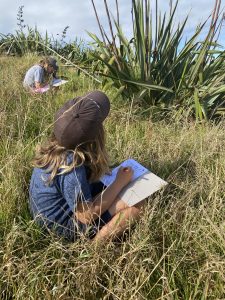
I wonder, I explore, I discover, I share.
Whanaungatanga – connecting
Whakatōmene – exploring
Whakapuawai – thriving
These are the Barefoot Learning Principles underpinning learning at Paekākāriki School. Developed in consultation with their community in 2017, they guide the culture of the school and recognise the importance of keeping our feet connected to Papatūānuku in order to make a positive difference in this world.
Principal, Julia Bevin, says it’s all about tamariki developing a deep connection with their local community and environment. This helps students develop a sense of belonging and citizenship. She stressed the importance of weaving play into this.
“It is through play and exploration that tamariki can truly experience and understand their place and each other. Play as a social activity is important for developing confident and capable learners and citizens.’ Julia Bevin, Principal
The approach reflects the thinking of David Sobel, an environmental educator whose writing has helped to shape place-based education around the world.
An established weekly programme focused on te taiao
With these principles in mind, they established a programme focused in te taiao within the school grounds: ‘Ngā Hononga ki a Papatūānuku’. The day-long programme – underpinned by te ao Māori concepts of rongoā, maramataka and te Whare Tapawha and te Whāriki – takes place once a week and is led by specialist raranga and rongoā kaiako Raima Kingi.
Ākonga rotate through:
- māra kai (spending time in the edible garden),
- kauta kai and kindness (cooking and sharing of kai for manaakitanga),
- rongoā and raranga (learning holistically about the native plants, their uses and the tikanga surrounding them).
“These approaches allow our tamariki and whānau to be learners, teachers, leaders and kaitiaki in our kura, hāpori, rohe and the wider world.” – Raima Kingi.

Ākonga have been learning the tikanga associated with using harakeke from the pā harakeke at their kura.
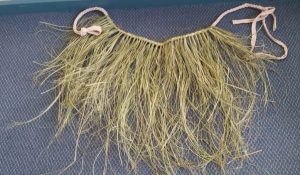
Ākonga collaboratively created this paki (ornamental cape).
In further consultation around their Health and Physical Education curriculum in 2020, Paekākāriki School whānau were really clear that they wanted the school to continue and extend using the natural environment for teaching and learning. They began taking their students on regular nature excursions and connected with Enviroschools to enrich these experiences.
Enriching the programme through connections with Enviroschools
For the last few years, Enviroschools Te Upoko o te Ika a Māui have had a particular focus on nurturing ecoliterate learners as the foundation for taking action within a sustainable community.
In 2020 Amanda, the Enviroschools Community Facilitator on the Kāpiti Coast, co-led a Kāpiti Teachers GO WILD event with Liana Stupples from Re-Wild yourself. Amanda and Liana supported teachers to be connected to nature for their own well-being and to give them simple ways to share this with their students.

Recording in Nature Journals.
When Jess, senior school teacher at Paekākāriki School, participated in this event, it gave her practical ideas and insights into how to bring meaning to place-based learning for ākonga. She took ideas such as nature journaling and a simple model of mihi from the Enviroschools resources back to her classroom immediately and has been using them over and over again.
“It helped me weave together culturally responsive kaupapa, core curriculum planning and innovative new teaching ideas around science, local history, technology, creative arts, mātauranga Māori, maths and well-being all in one meaningful context.”
Jess was also delighted to gain access to a wider network of other teachers, students and providers.
“It was just the beginning, it made me realise the potential of the human resources that are in our reach if we work with the Enviroschools Network, from experts in water quality, marine environments to those knowledgeable in ways to engage mindfully with the environment, to mana whenua, with unique knowledge of history, rongoā and tikanga.”
Regular excursions into local natural areas
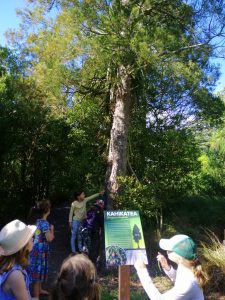
Exploring the Kaitawa Reserve ‘Outdoor Classroom’.
During Terms 1 and 2 of 2021, Ngā Kākano (years 2-4) headed out once a week to investigate and explore Campbell Park and Queen Elizabeth Park, which are within walking distance.
They also regularly visited Kaitawa Reserve, which the Friends of Kaitawa Reserve have developed into an outdoor classroom setting. With its remnant bush and over 20 years of restoration planting by Kāpiti Mana Forest and Bird, it’s a special local place to visit.
Their tuakana in Years 5-8 head to the Wainui estuary each week. Amanda from Enviroschools has supported their place based learning programe by introducing the Marine Metre Square (MM2) Citizen Science Kit as an exploration opportunity and supported them to engage with the Litter Intelligence Education Project (LIEP) professional development led by Sustainable Coastlines.
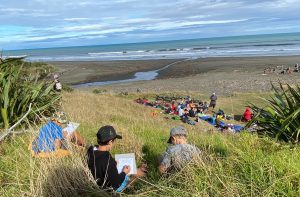
Ākonga spend each Tuesday morning at their local estuary.
“By timetabling our nature days on a Monday morning we have noticed a reduction in behaviour and social problems after an often busy weekend. It’s a great way to start the week.” – Judith, Ngā Kākano Teacher (Middle school)
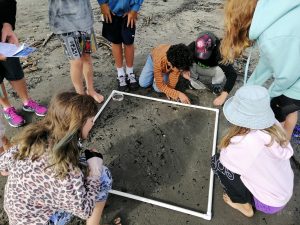
Exploring the Marine Metre Squared citizen science tools.
The school now regularly monitors litter for the LIEP citizen science programme, and has begun eDNA testing in Wainui awa with local hapū Ngāti Haumia.
The outdoor exploration days have been a great success with excellent feedback from students and whānau.
Building on emerging interests
These experiences in the environment spark interests and passions in the students leading to inquiry learning across the breadth of the curriculum.
“Our curriculum planning is developed together as a team, in response to observations that we have made around student urges, misconceptions or happenings. By prioritising ‘active noticing’ we are able to create a rich curriculum that is both timely and relevant.” Rachel McMullen, senior school lead kaiako
This fits well with the STEAMM approach where Science, Technology, Engineering, the Arts, Mathematics and Mātauranga Māori provide access points for inquiry. A wide range of interest areas have emerged – from propulsion to te ao Māori values, to poetry.
The connections the students make with their environment are evident in this excerpt from 12 year old Kyon Tuiileila’s poem:
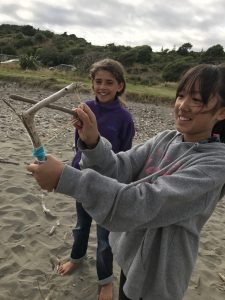
Designing and building devices that propel.
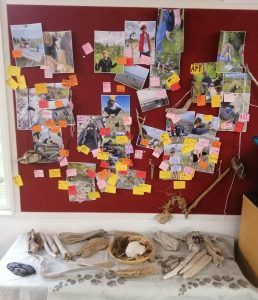
Making connections between experiences in te taiao and a range of curriculum areas.
“The wind is blowing wildly,
the leaves are releasing off their trees,
raindrops are dropping to the ground,
And clouds are storming over my head
But it’s a beautiful mess”
A developing sense of citizenship
In May 2021, the students’ sense of connection to the world they live in was also obvious when they worked with Sophie Handford (local ward councillor for Paekākāriki and ex-student of both Paekākāriki School and Kāpiti College) to make submissions to the council’s Long Term Plan process.
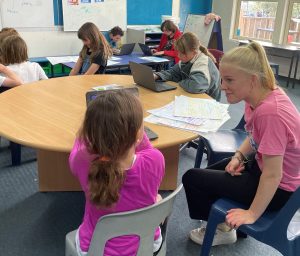
Sophie Handford supporting ākonga to prepare submissions.
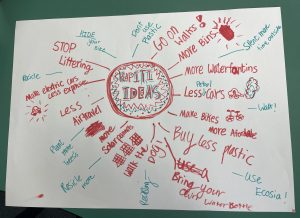
Changes the students have in mind.
Issues they raised included plastic packaging, insufficient public transport, the need for a larger, stricter marine reserve and wanting to see action to back up the climate emergency declaration.
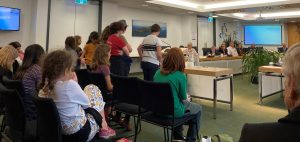
Speaking to submissions at Kāpiti Coast District Council hearings.
An ongoing journey for the whole community
Parents value what this programme brings to their community.
“I believe our tamariki are very lucky to be in the position of learning through this [place based] medium and am so pleased my child, and therefore my whole whānau, get to benefit.” – Parent
Enviroschools are also privileged to be able to walk alongside Paekākāriki School to support them as they continue to integrate place-based learning and education for sustainability across the whole school.
